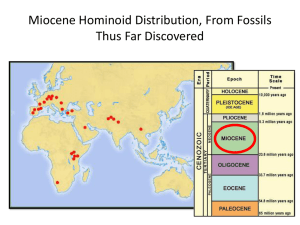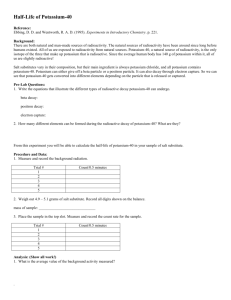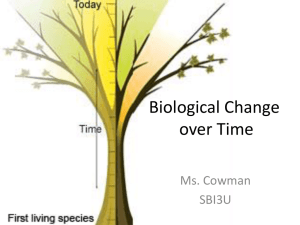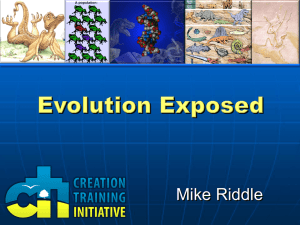The Age of Things: Sticks, Stones and the Universe
advertisement
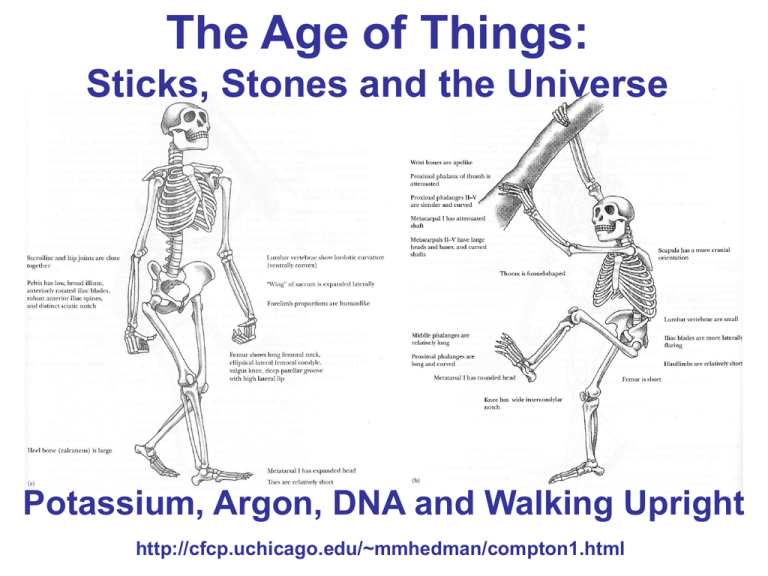
The Age of Things: Sticks, Stones and the Universe Potassium, Argon, DNA and Walking Upright http://cfcp.uchicago.edu/~mmhedman/compton1.html Proconsul WARNING! Astrophysicist talking about Paleoanthropology Australopithecus Sivapithecus Proconsul Australopithecus Sivapithecus Proconsul Hominids 0 Paranthropus robustus Homo sapiens 1 mya 2 mya Australopithecus africanus Homo erectus Homo habilis 3 mya 4 mya (mya = millions of years ago) Australopithecus afarensis Paranthropus bosei All these hominids could walk on two legs Australopitchecus afarensis Recent hominid finds Orrorin tugenensis Age of the fossils Based on Geological Data Sahelanthropus tchadensis Time when hominids first became bipedal Based on Molecular Data Potassium-Argon Dating Carbon 14 Proton Neutron Nitrogen 14 electron neutrino Potassium 40 Calcium 40 electron neutrino Potassium-40 has two ways it can decay Potassium 40 Calcium 40 90% electron neutrino Potassium 40 Argon 40 10% electron neutrino R= Current amount of Potassium-40 Original amount of Potassium-40 R Half-Life of Potassium-40 is1.25 billion years Potassium-40 decay in molten rock Potassium-40 Argon-40 Calcium-40 Potassium-40 decay in solid rock Potassium-40 Argon-40 Calcium-40 The Rock Today Potassium-40 Argon-40 Calcium-40 The Rock Today Potassium-40 Argon-40 Potassium 40 The Original Rock Calcium-40 Calcium-40 The East African Rift System Red Circles=Earthquakes Green triangles=Volcanoes 2.5 Million Years Ago 3 Million Years Ago Ardipithecus ramidus Ardipithecus ramidus Recent hominid finds Orrorin tugenensis Age of the fossils Based on Geological Data Sahelanthropus tchadensis Time when hominids first became bipedal Based on Molecular Data Molecular Dating Methods WARNING! Astrophysicist talking about Molecular Biology C C CAAGAG T T C C CAAGAG T T Molecular Dating Methods C C CAAGAG T T C C CAAGAG T T Mutations in DNA Original CCCAAGAGTTCCCAAGAGTT Substitution CCCATGAGTTCCCAAGAGTT GAGT Deletion CCCAATCCCAAGAGTT Insertion CCCAAGAGTTCACTTCCAAGAGTT Inversion CCCAAGCTTGACCAAGAGTT The accumulation of mutations over time CCCATGAGTT CCCAAGAGTG GCCATGAATT CCTCAGAGTG CCCAAGAGTT TIME CCCAAGAGTT The accumulation of mutations over time GCCATGAATT CCTCAGAGTG CACCAGAGTG CCCCAGAGTG TIME CCCAAGAGTT Could mutations accumulate at a constant rate ? Two conditions must be met 1. Mutations occur at the same rate in all animals Possible, mutations are due to biochemical processes that are almost identical in different animals 2. Mutations are equally likely to be passed on in all animals Unlikely, if mutations affect physical characteristics of animal (Rate depends on environment, etc.) True if mutations have no impact on the health or appearance of the animal Neutral or “Silent” mutations Identifying “useful” regions of DNA Proconsul Molecular Dating in Humans and Apes TAGGATCGATATAAGATAGCCGAACGAGACTATGGCTAGAGTGCATAGAC TAGGATCGATATAACATAGCCGAACGAGACTATGGCTAGAGAGCATAGAC TAGGATCGATATAAGATAGCCGATCGAGACTATGGCTAGAGAGCATAGAC TACGATCGATATAAGATAGCCGAAGGAGACTATGGATAGAGAGCATAGAC Human Chimp Gorilla Human Chimp 1.24% Gorilla 1.62% 1.63% Orangutan 3.08% 3.12% 3.09% Chimp Gorilla Orangutan Human Chimp Gorilla Human Chimp 1.24% Gorilla 1.62% 1.63% Orangutan 3.08% 3.12% 3.09% Chimp Gorilla Orangutan 1% 2% 3% Proconsul Sivapithecus Calibrating the molecular clock Human Chimp Gorilla Orangutan 1% Sivapithecus 2% 3% Proconsul Proconsul Sivapithecus Calibrating the molecular clock Millions of years ago Human Chimp Gorilla Orangutan 1% 5 10 Sivapithecus 2% 3% 15 Proconsul Ardipithecus ramidus Estimated time when humans and chimps last had a common ancestor Next Time: Molecular Dating and the Many Kinds of Mammals

